Planning 2 days in Seville? Here’s the perfect itinerary for a first-time visit.
Oh, Seville. After only two days in this magical city I left with a dream of living here one day, or at the very least coming back again multiple times. It’s a city that’s so walkable, with such a relaxed vibe. No one seems to be in a hurry, everyone seems to be enjoying life.
We packed in incredible architecture, delicious food, and plenty of the city’s rich culture and history into only 2 days in Seville – although I would have loved to spend more time there! Seville was definitely one of the highlights of our Andalucía road trip.
If you’re like me and only have two days in Seville, here’s how I recommend you plan your itinerary to make the most of your short time here.
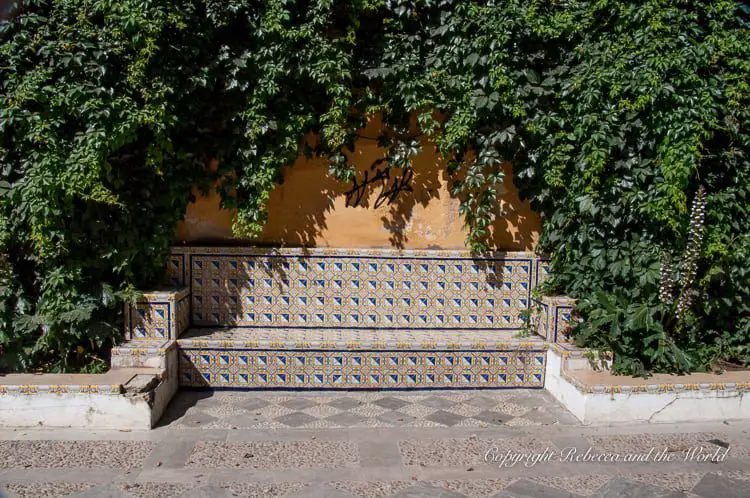
This blog post may contain affiliate links, meaning if you book or buy something through one of these links, I may earn a small commission (at no extra cost to you).
Is 2 days in Seville enough?
Two days is a great amount of time to hit the highlights of Seville. You can squeeze in the main Seville attractions, plenty of food and great nightlife if you have two full days and three nights. Two days should really be the minimum amount of time you plan to spend in Seville.
But having spent two days in this city and seen just how much there is to do, I think you could easily spend a week here!
The perfect Seville itinerary
Here’s my recommendation for how to create the perfect 2-day Seville itinerary.
- Day 1: Architecture, tapas and flamenco
- Day 2: Beautiful parks and outdoor spaces, evening strolls
Map of what to see in Seville in 2 days
Let’s start off with a map of the the best Seville attractions so that you can picture where everything is. As you can see, this itinerary sticks within a small area of the city, so it’s easy to walk around to visit each site.
Day 1
I recommend arriving the night before you so can kick off two full days in Seville.
Real Alcázar
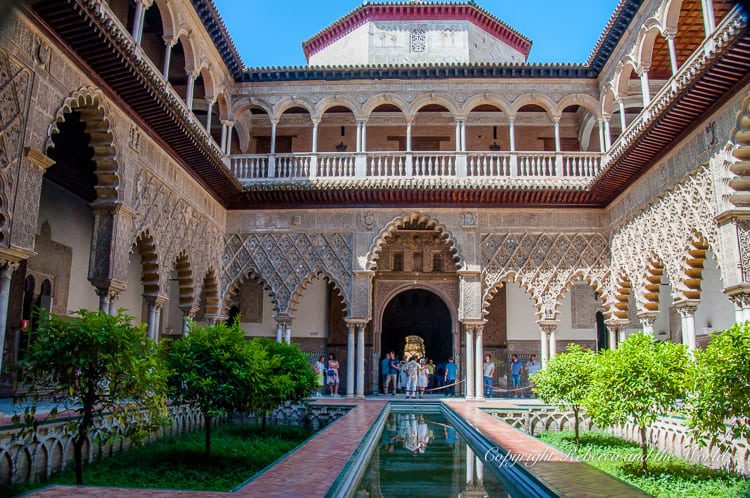
Start your visit to Seville in the heart of the city. I’d been blown away by the stunning architecture of the Alhambra in Granada, and Seville proved no different.
The Real Alcázar is absolutely gorgeous and something you absolutely cannot miss in Seville. It’s a popular spot, so you must buy tickets in advance.
The Real Alcázar – or the royal palace – is the oldest royal palace still in use in Europe. It was declared a UNESCO World Heritage site in 1987.
Spend a few hours wandering through the palace grounds, exploring the beautifully manicured gardens and the intricate Islamic and Christian influences in each room.
The Real Alcázar is so stunning that it was chosen as the setting for Dorne, the fictional home of the House of Martell in Game of Thrones.
This is one of the top Seville tourist attractions, so make sure to buy your tickets online in advance as the queue usually snakes all the way around the corner. I recommend going early in the morning to avoid the crowds.
One thing I wish we’d done when we visited the Real Alcázar is book an actual guide so we got some more information about what we were looking at. This skip-the-line, 90-minute tour looks like a good option (and gets great reviews).
To visit the upper royal apartments – still in use by the royal family today – you’ll pay an extra fee and this must be booked in advance as the entrances are timed.
Cost
Tickets for the palaces and gardens cost €14.50, and €20 for tickets that include entrance to the upper royal apartments.
Opening hours
The Real Alcázar is open from Monday to Sunday, 9.30am to 5pm from October to March, and from 9.30am to 7pm from April to September. The palace is closed on January 1 and 6, Good Friday and December 25.
Seville Cathedral and La Giralda
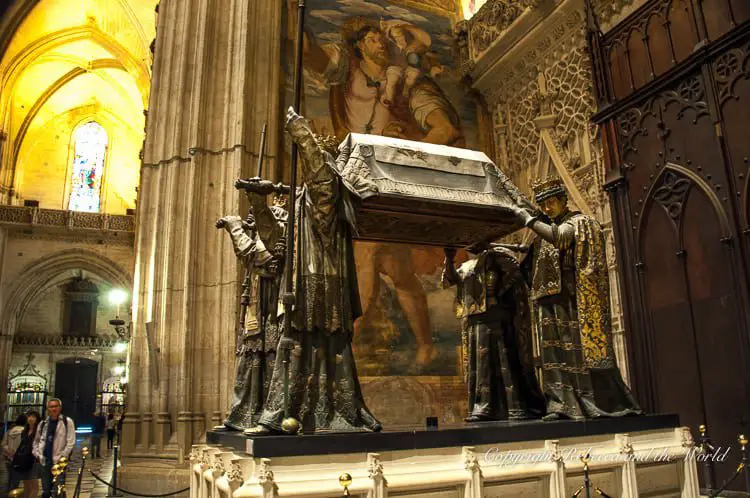
You could easily spend a whole day at the Real Alcázar but we don’t have the time in this itinerary, so scoot off to the Seville Cathedral, followed by a climb to the top of La Giralda for the views over Seville.
We stayed in Barrio Santa Cruz and we passed by the Seville Cathedral at least two or three times every day as we explored the city. At night, it’s imposing in its grandeur, glowing golden in the darkened sky.
Inside, the cavernous building is filled with delicate leadlight windows, and ornaments and altars dripping with gold.
The cathedral is the final resting place of Christopher Columbus. Even if you’re not into churches, the cathedral is one of the highlights of Seville.
You can climb to the top of La Giralda, once the ancient minaret of the demolished mosque that stood on this site, and now the bell tower. It’s almost 100 metres high, but don’t stress: the way up to the top is a gently ascending ramp that is far easier than stairs (although there are still “are we there yet?” moments). From the top there are great views out over Seville.
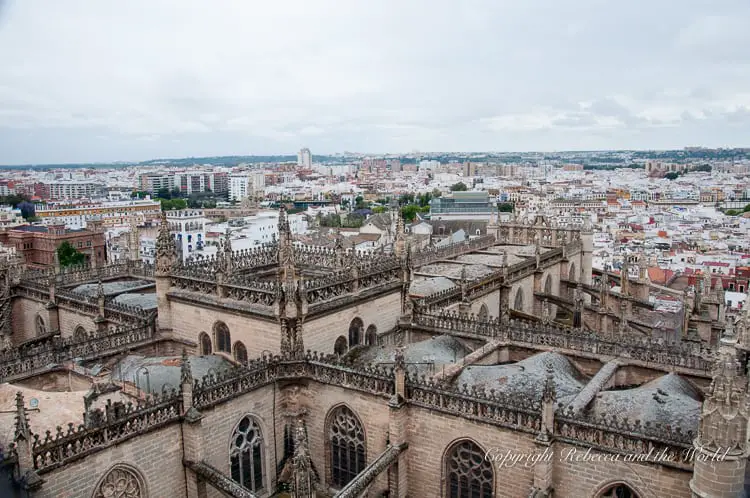
If you’d prefer to have someone guide you through the Cathedral and La Giralda, this 90-minute tour is a good option (and means you don’t have to line up for tickets). This 3-hour guided tour adds on the Real Alcazar.
Cost
General admission is €12 (online) and €13 (if bought at the box office). During peak season, buy your tickets in advance and online to avoid the queues.
Opening hours
The cathedral is open: Monday to Saturday – 11am to 5pm; Sunday – 2.30pm to 6pm
Break for lunch
Sevillanos seemingly adore eating, and I loved passing by bars at lunch time when the outside tables were full of people picking at plates of jamón with a caña (small glass of beer) in hand. The Spanish certainly know how to enjoy life!
On day 1, I recommend stopping for lunch at Bodega Santa Cruz, a typical tapas bar that’s usually pretty lively.
Calle Rodrigo Caro, 1A
Opening hours: Monday to Wednesday, Sunday 8.30am to midnight; Thursday 8.30am to 5pm; Friday 8am to midnight; Saturday 8am to 1am
Bullfighting ring and museum
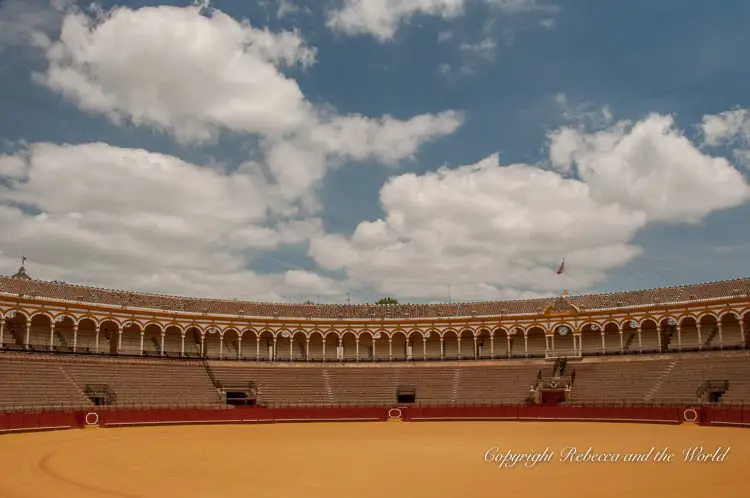
Next, take a tour of the bullfighting ring. While I don’t encourage this bloody sport, it is an important part of Spanish culture, and a tour gives an overview of the history of bullfighting in Spain.
The bull ring – the Plaza de Toros de la Real Maestranza de Caballería de Sevilla (how’s that for a mouthful?) – is worth a visit to understand this controversial sport.
Visits can only be done as part of a 1-hour guided tour. You can access an audio guide through your own mobile phone, and will be led through each section of the museum by a bilingual guide (trilingual in our case, she switched between English, Spanish and French without blinking).
It does feel rushed because the audio guide’s descriptions of each place are quite lengthy and you barely get to finish each one before you’re shuffled on to the next part. Still, it’s interesting to learn about some of the most famous matadors and to sit in the plaza de toros imagining the crowd going wild and the bulls’ terror.
Cost
€10 for the guided tour. If it’s peak season, book a skip-the-line ticket online to reserve your spot.
Opening hours
Daily, 9.30am to 7pm (closed December 25)
Tapas bar crawl
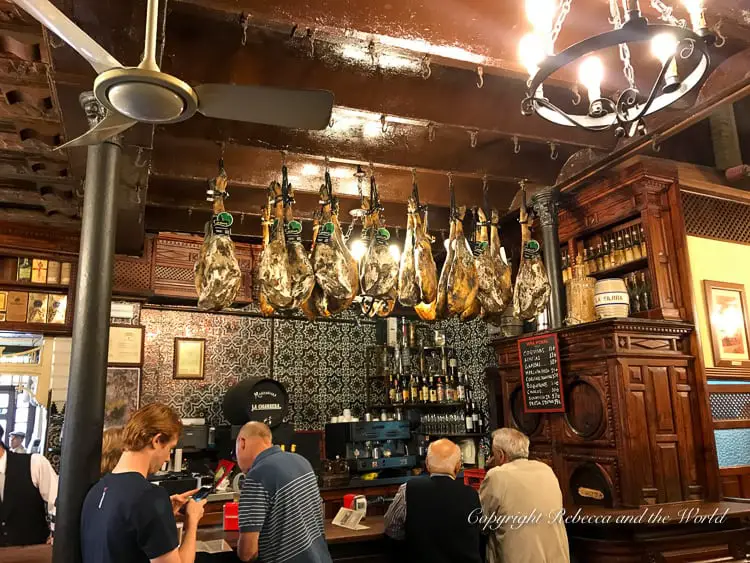
Plan for a siesta in the afternoon before heading out for tapas for dinner. Food is so important in Spain there’s even a verb for the art of enjoying tapas – tapear!
I have a full guide to the best tapas bars in Seville, so you should plan to stop at 2 or 3 – or 5! – to try different dishes and mingle with Sevillanos.
With only 2 days in Seville, you’re not going to get a chance to try everything, but you can certainly do your best! Two bars I suggest are:
El Rinconcillo (Calle Gerona, 40) is the oldest bar in Seville. It was opened in the late 1700s and doesn’t appear to have changed much since then. Try the jamón bellota – it’s pricey but totally worth it. This type of jamón comes from acorn-fed pigs who wander through the forest and it’s one of the most expensive (and delicious) hams on the market.
For a fun atmosphere, try Bodeguita Romero (Calle Harinas, 10), which has been run by the same family for generations. We went a couple of times during our 2 days in Seville, and it was always packed with people no matter the time of day. Have three or four tapas with a glass of tinto de verano or a local beer.
Catch a flamenco show in Seville
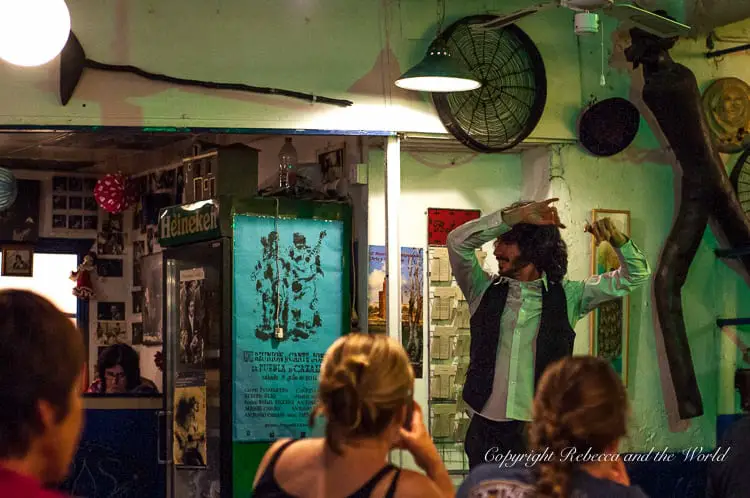
For an authentic experience of flamenco in Seville, grab a seat at one of the huge communal tables at La Carbonería and wait for the passionate performance to start.
Sure, the place is filled with tourists, but the shows (which don’t seem to follow a set schedule, as far as I can tell) feel more intimate and not flashy. Go around 10pm.
Calle Céspedes, 21
Free entrance
Open daily 8pm to 1.30am
For something more touristy but no less authentic, Casa de la Memoria holds two flamenco shows every night in a small theatre. Sit in the front row and expect to be sprayed with sweat from the no-holds-barred performers. Book tickets online here.
Calle Cuna, 6
€22
Shows held nightly at 6pm, 7.30pm and 9pm
We went to both of these shows during our time in Seville. La Carboneria was more relaxed, while the show at Casa de la Memoria was more formal and on a stage.
Day 2
Your first day in Seville was a big one, so have a sleep in.
Breakfast
Then, grab a traditional Spanish breakfast of eggs, pan con tomate y jamón, fresh orange juice, coffee and pastries. This is a typical dish, so you’ll find it on any Spanish cafe menu.
This will fuel you up for another busy day of sightseeing in Seville.
Plaza de España
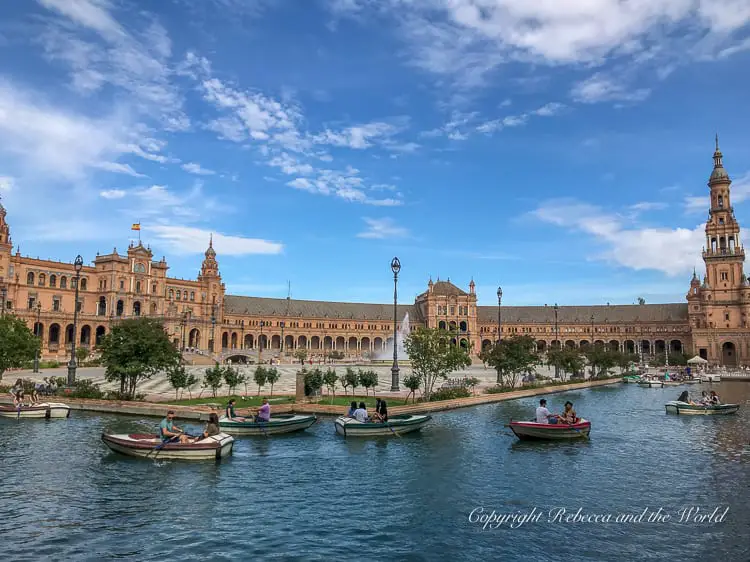
Start the day by wandering around the Plaza de España.
Built in the 1920s when Seville hosted the Ibero-American Exposition World’s Fair, the huge half moon-shaped building is now home to government offices.
Spend some time exploring the ornate mosaic tiles of the alcoves that represent each of the provinces in Spain. This plaza really is one of the most beautiful things to see in Seville.
If you’ve got the energy (and it’s the right time of year) you could hire a rowboat and join the couples and families rowing their way around the moat.
It’s a gorgeous place and, for me, a must-see in Seville.
Parque de María Luisa
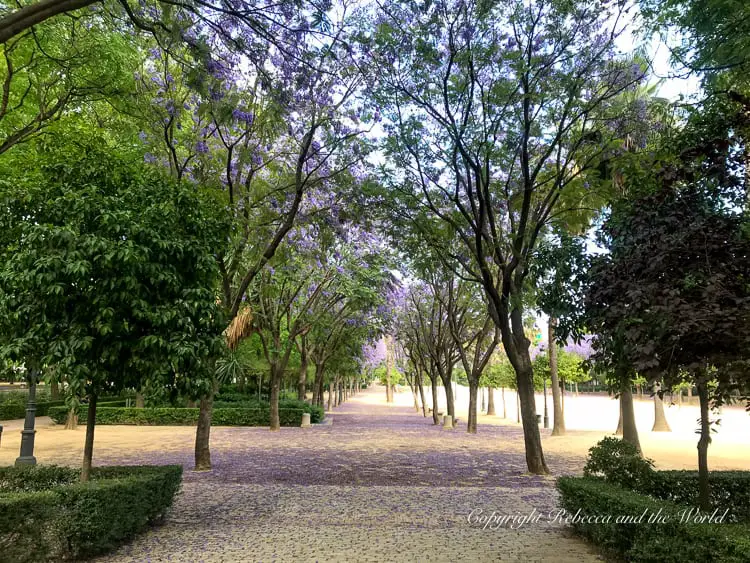
Just across the road from Plaza de España is Parque de María Luisa. This large park is dotted with orange trees, hidden fountains and tiled benches. It took us more than half an hour to wander from one side to the other.
You can even hire bikes to explore the gardens for an afternoon. It’s the ideal spot for a picnic or to rest from the heat of Seville in summer.
Casa de Pilatos
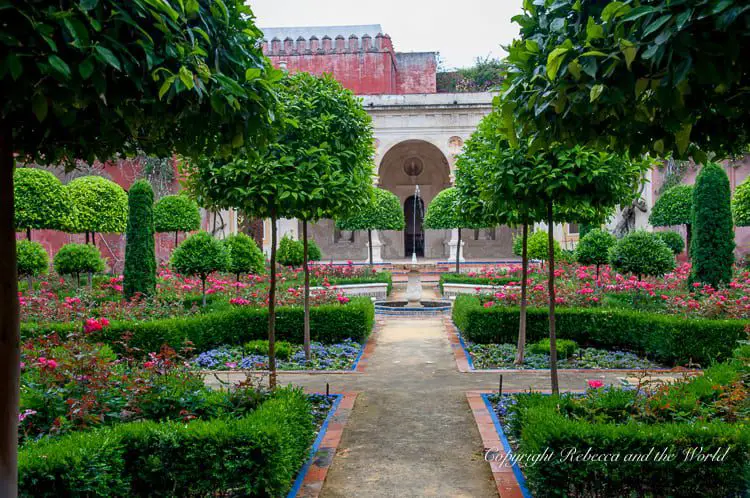
Take a leisurely stroll back through the city to Casa de Pilatos to explore this 15th century home.
I don’t think I would have put the Casa de Pilatos on our Seville itinerary if a friend of mine hadn’t recommended it to me. I’m so glad she did. We found it to be far less touristy than other sights in Seville – but no less impressive.
This gorgeous Andalucían palace is adorned with thousands and thousands of beautiful tiles and is a mixture of Italian Renaissance and Spanish Mudéjar styles. It was opened in 1483 and is still occupied by the Dukes of Medinaceli.
Cost
For a ticket to view the entire complex (with a guided tour of the upper floor) you’ll pay €18. A ticket for the ground floor only is €12. Tickets include an audio guide in multiple languages.
There’s usually no need to buy tickets in advance.
Opening hours
The Casa de Pilatos is open daily from 9am to 6pm.
Metropol Parasol
In the evening, wander the rooftop of Metropol Parasol.
Also known as Las Setas because of its resemblance to mushrooms (setas are mushrooms in Spanish), this unique structure is the brainchild of German architect Jürgen Mayer. At 26 metres high, the Metropol Parasol is one of the largest wooden structures in the world.
It’s not without controversy, due to its appearance and the cost to construct it.
At night, it’s beautifully illuminated, with great views of Seville. You can take the elevator to the top and weave your way across the top of the mushrooms via the walkway.
Cost
To get access to the rooftop walkways costs €15. This includes an immersive video show, light show and the view point.
Opening hours
Daily, 9.30am to 12.30am (last access 11.30pm)
Wander Barrio Santa Cruz in the evening
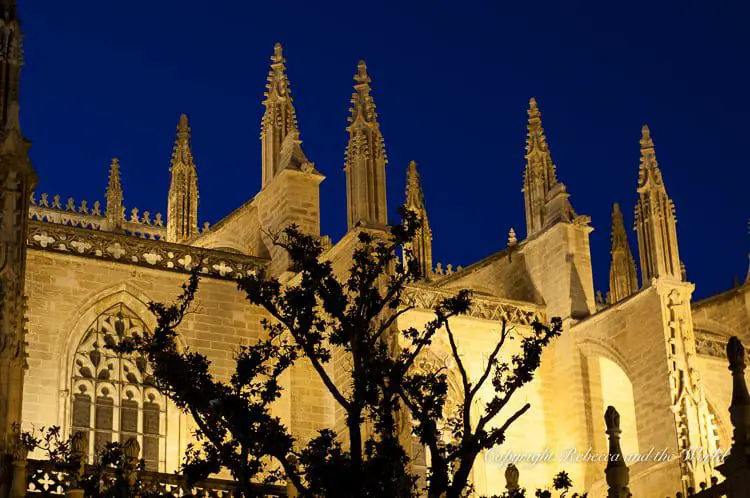
Hit up the tapas bars you didn’t get to last night.
As you’re heading from one tapas restaurant to another in the evening, take some time to linger around Barrio Santa Cruz.
Near the cathedral you’ll see buskers and street performers drawing small crowds. In the summer evenings, the vibe is relaxed and happy and you never know what kind of a show you’ll stumble on. We were transfixed for a while by two guys playing The White Stripes’ Seven Nation Army on violins.
Finish the evening with more tapas and chatting with friendly Sevillanos in the bars.
If you’ve got more than 2 days in Seville…
Well, lucky you! Got 3 days in Seville or even a week? Here are some suggestions for even more places to see in Seville:
- Take a day trip or two. I’ve got a separate article with ideas for day trips from Seville – you can even take a day trip into Portugal!
- Learn about maritime history at the Torre del Oro (Gold Tower). This tower was once a military watchtower and also a prison.
- Head over the river to Triana to experience a more local area of Seville. In Triana you can wander through the Mercado de Triana, eat some more tapas (try this guided tour) or shop for beautiful tiles. Triana is also known as the heart of flamenco, so check out a local flamenco show here.
- If you’re a Game of Thrones fan or a history buff, head out to Italica to see the ancient Roman amphitheatre (ie. where Cersei first saw a white walker). You can take public transport or join a bike tour.
- Take a Spanish cooking class inside the Triana market where you’ll learn how to make typical Spanish dishes.
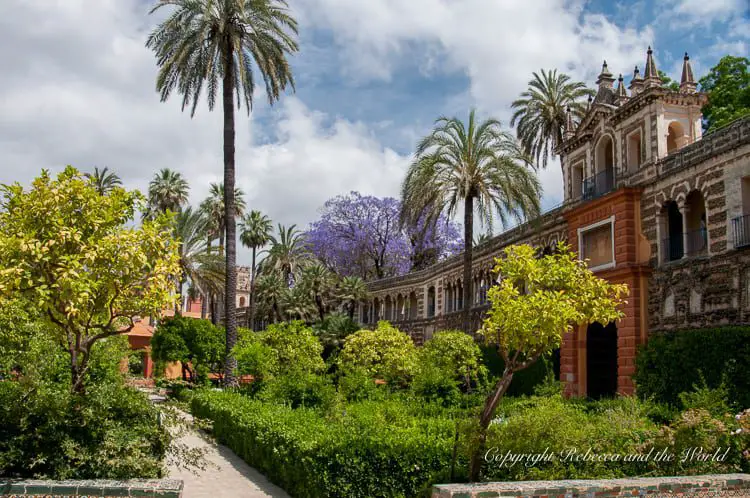
Seville travel guide
Now that you know what to do in Seville, here’s some important planning information.
Best time to visit Seville
If you’re wondering when to visit Seville, well, like the rest of Andalucía, there’s not really a bad time to visit Seville. But of course there is a best time to visit Seville, and I’d say that that’s the months on either side of summer. At this time of year – May and June, October – you’ll find the weather cooler and there’ll be fewer crowds. I visited Seville in June and we had such lovely weather each day, with warm, sunny days and cooler evenings.
In March and April there are two big festivals to be aware of. You’ll either want to avoid these or plan in advance to be in Seville so you can join in on the fun. The two festivals are Semana Santa (Easter) and Feria de Abril (carnival) and the city (and most of Spain) is packed during these weeks.
Seville is H-O-T in summer. July and August are also months when many Spaniards pack up the house and head off on their own summer holidays, so you if you visit then, you may actually find yourself in Seville surrounded by foreigners and few people from Spain!
Winter months are relatively mild but there can be quite a bit of rain. If you time your trip in January or February you can avoid most of the rain and take advantage of the shoulder season’s lower prices.
How to get around Seville
By far the best way to get around Seville is on your own two feet. It’s an easily walkable city and even with only 2 days in Seville you’ll clock up some miles as you explore everything the city has to offer.
If you arrive in Seville by car, you’ll face challenges finding parking and driving down narrow, one-way streets. It’s not a fun way to begin a holiday (trust me). Check with your hotel first to see if they have parking or can tell you the closest public parking options. Public car garages cost between €12 and €24 a day.
Taxis in Seville are plentiful. Make sure to have small change. Most taxis accept credit card as well.
Seville’s bus system is extensive and the C1, C2, C3 and C4 lines will take you to the best Seville attractions. Tickets cost €1.40 per trip, but you can purchase a multi-trip card (Bonobus – €6 for 10 trips) which reduces the costs of each journey.
You can use this same card on the tram (called the Metro-Centro). The tram has a fairly small network, covering only 1.4 kilometres and four stops. Although nowhere near as extensive as the bus network, you can still use the tram to access many of the best things to do in Seville.
Like many major cities around the world, Seville also has a bike rental system. The first 30 minutes are free, and then you pay after that. You’ll need to pay a deposit of €150 (fully refunded at the end of your subscription).
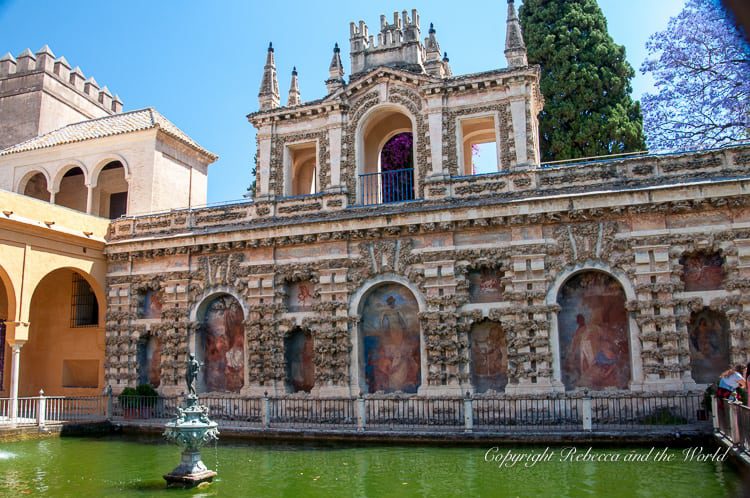
Where to stay in Seville
You won’t be at a loss to find somewhere to stay in this city. There are some beautiful hotels in Seville, many of which are in former palaces or mansions. The best area to stay in Seville is Barrio Santa Cruz, where you’ll be close to the main sights.
- Casa del Poeta (Calle Don Carlos Alonso Chaparro) has a rooftop terrace with views of the cathedral | Check rates and availability on Booking.com or Expedia
- Hotel Amadeus (Calle Farnesio, 6) is a short walk from the Real Alcazar and the cathedral | Check rates and availability on Booking.com or Expedia
- If you’re travelling solo or on a budget, check out the best hostels for solo travellers in Seville.
Did you find this article helpful? Consider buying me a coffee as a way to say thanks!
Have you fallen in love with Seville? How would you spend 2 days in Seville? Leave your tips in the comments below!
Related posts
Before you go… you might like these Spain travel guides.
- How to Plan a 7-Day Southern Spain Itinerary
- Where to Find the Best Tapas in Seville: 7 Must-Visit Tapas Bars
- 2 Days in Granada, Spain: Tasty Tapas, Historic Neighbourhoods and the Amazing Alhambra
- 13 Things To Do in Ronda, Spain: The Prettiest Town in Andalucía
- 12 Brilliant Day Trips From Seville
- Buying Tickets for the Alhambra: Everything you Need to Know (Plus What to Do if They’re Sold Out!)
SPAIN TRIP ESSENTIALS
- Book flights to and around Spain online with Skyscanner. I like this site because it shows me which dates are cheaper.
- Find a great hotel in Spain. Check prices on Booking.com and Expedia online.
- For train travel, Omio should be your starting point for checking routes and booking tickets.
- Check out the huge range of day tours throughout Spain on GetYourGuide or Viator. There’s something for everyone.
- A copy of the Lonely Planet guide to Spain will be handy, along with a Spanish language phrasebook.
- One thing I always purchase is travel insurance! Travel Insurance Master allows you to compare across multiple policy providers, while SafetyWing is great for long-term travellers and digital nomads.
PIN IT FOR LATER: SEVILLE 2 DAY ITINERARY
Save this guide to 2 days in Seville to Pinterest for your travel planning later.
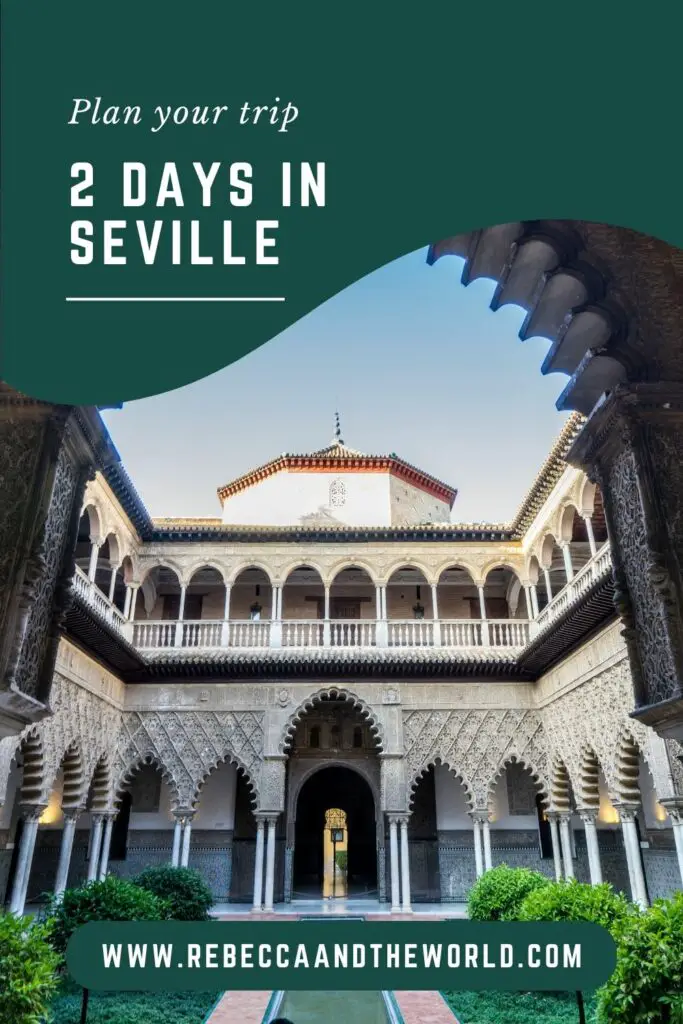
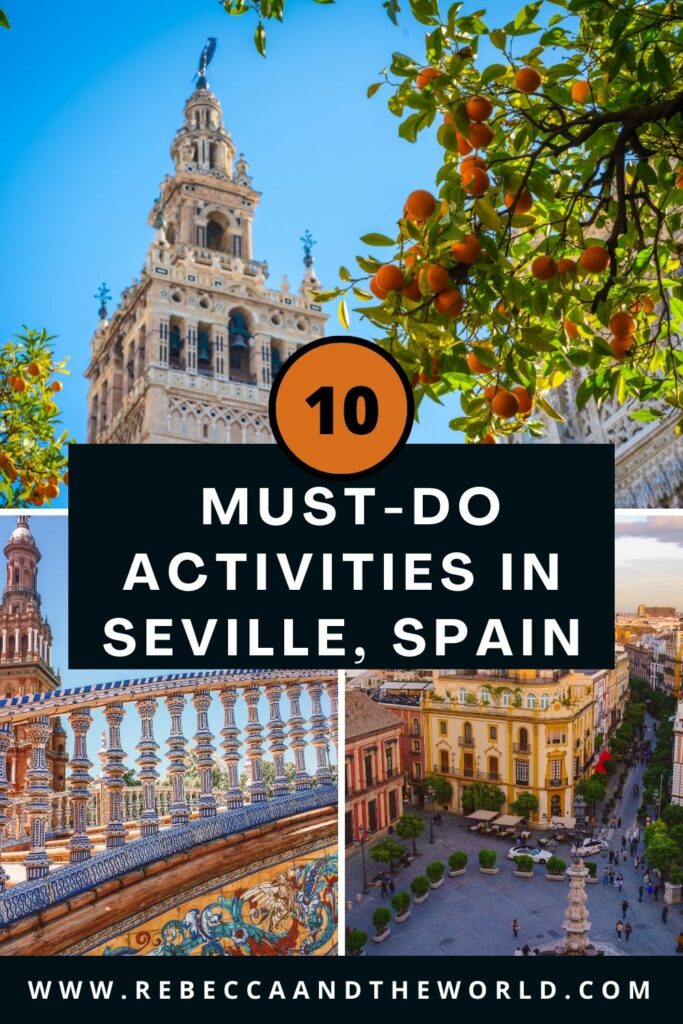
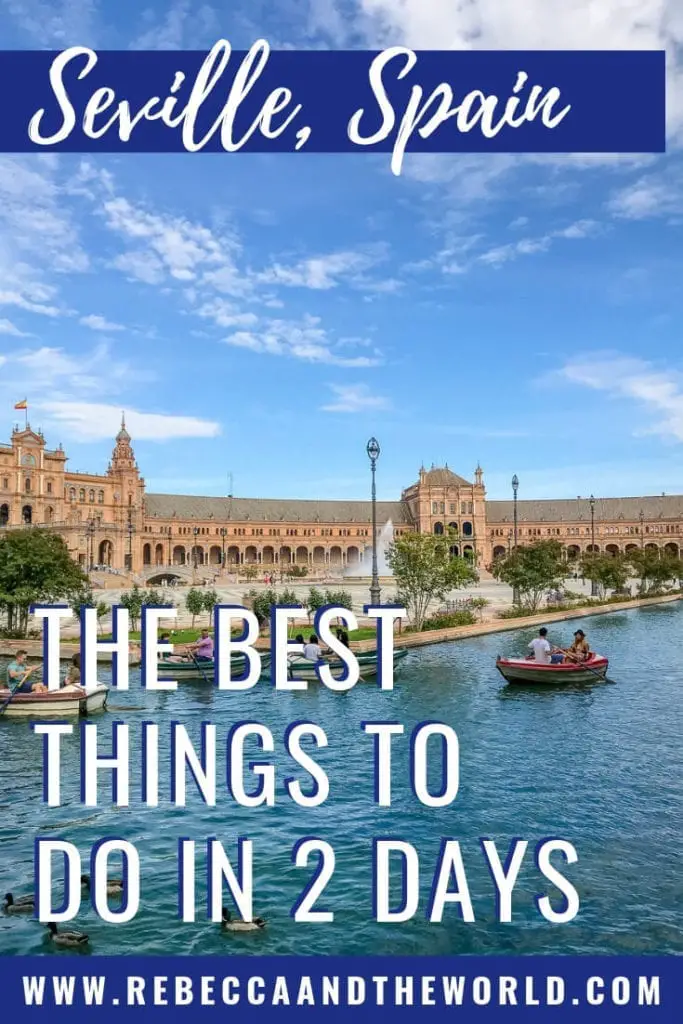
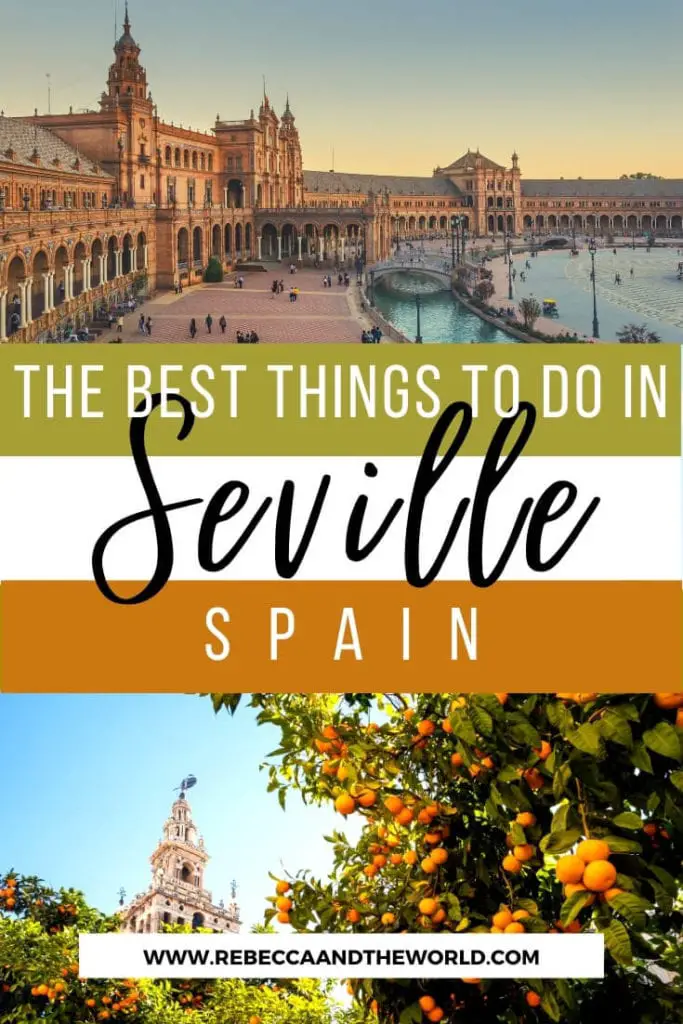
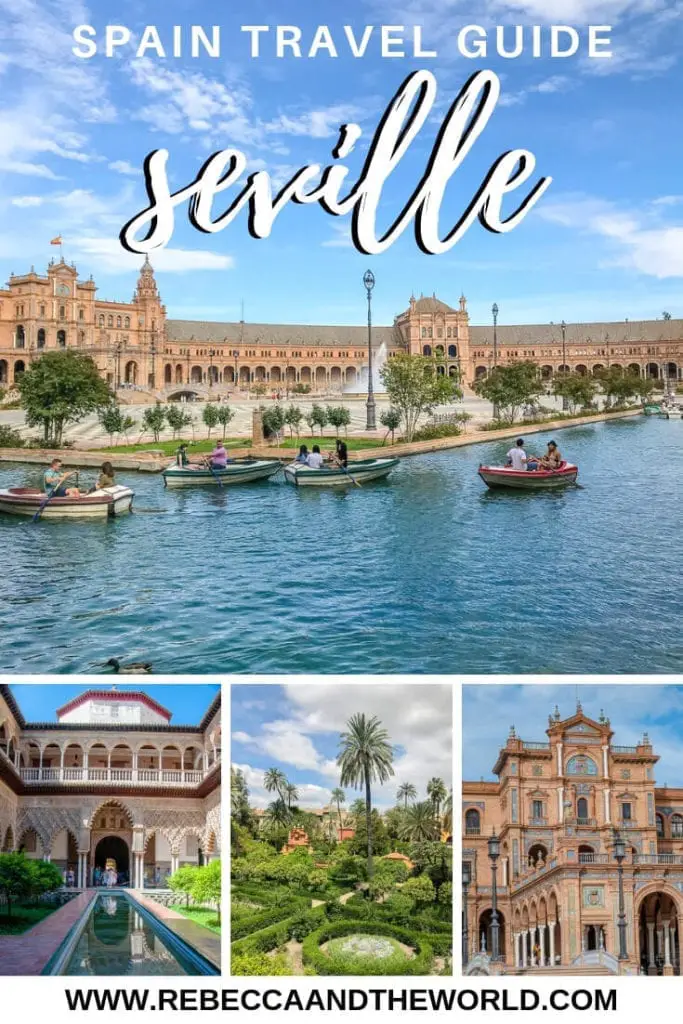
This post was published in September 2018, and was updated in October 2019 and March 2024.

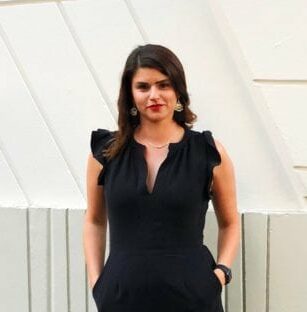

Your photos are stunning! I’ve never been to Spain, but I’m dying to go. Did you think 2 days was long enough to visit Seville, or would you recommend spending more time there?
-Claire
tallgirlbigworld.com
Thank you so much Claire! I think you can see plenty in two days – but if you have more time, I’d definitely recommend it. 3 or 4 days would be perfect. Let me know if you have questions about anything specific. Are you planning to go soon?
I’ve been thinking about visiting Seville for a while now, and I think you’ve just sealed the deal! It’s a stunning looking, with many more places to visit than I was expecting – Casa de Pilores is new to me but looks incredible. Thank you for the inspiration.
Yes, go book that flight girl!! It’s a really beautiful, relaxing city – I would love to live there.
So glad to come across your post! I’m heading to Seville in summer 2019 and these are great tips. Hoping to catch a flamenco show! 🙂
Awesome! You’ll have an amazing time. Check out a few different flamenco shows if you have the time, you’ll see different styles and interpretations.